Nîmes
|
Nîmes |
||
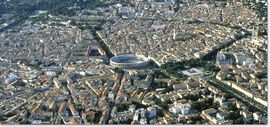 |
||
|
|
.svg.png) |
|
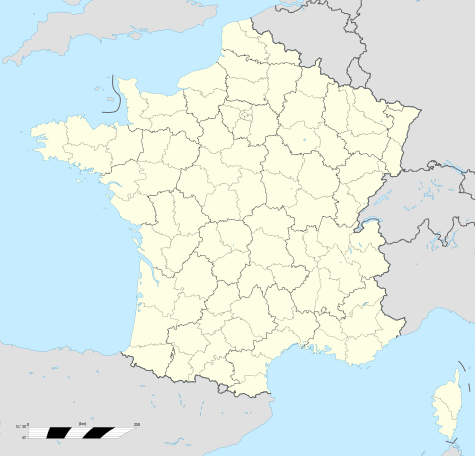 Nîmes
|
||
| Administration | ||
|---|---|---|
| Country | France | |
| Region | Languedoc-Roussillon | |
| Department | Gard | |
| Arrondissement | Nîmes | |
| Canton | 6 cantons | |
| Intercommunality | Nîmes Métropole | |
| Mayor | Jean-Paul Fournier (2008–2014) |
|
| Statistics | ||
| Elevation | 21–215 m (69–705 ft) (avg. 39 m/128 ft) |
|
| Land area1 | 161.85 km2 (62.49 sq mi) | |
| Population2 | 146,454 (2007) | |
| - Density | 905 /km2 (2,340 /sq mi) | |
| INSEE/Postal code | 30189/ 30000 and 30900 | |
| 1 French Land Register data, which excludes lakes, ponds, glaciers > 1 km² (0.386 sq mi or 247 acres) and river estuaries. | ||
| 2 Population sans doubles comptes: residents of multiple communes (e.g., students and military personnel) only counted once. | ||
Nîmes (Provençal Occitan: Nimes) is a city in southern France. It is the capital of the Gard department in the Languedoc-Roussilon. Nîmes has a rich history, dating back to the Roman Empire, and it is a popular tourist destination.
Contents |
History
The city derives its name from that of a spring in the Roman village. The contemporary coat of arms of the city of Nîmes includes a crocodile chained to a palm tree with the inscription COLNEM, for Colonia Nemausus, meaning the 'colony' or 'settlement' of Nemausus, the local Celtic god of the Volcae Arecomici. Veterans of the Roman legions who had served Julius Caesar in his Nile campaigns, at the end of fifteen years of soldiering, were given plots of land to cultivate on the plain of Nîmes.[1]
The city was located on the Via Domitia, a Roman road constructed in 118 BC which connected Italy to Spain.
Prehistory
The site on which the built-up area of Nîmes has become established in the course of centuries is part of the edge of the alluvial plain of the Vistrenque River which butts up against low hills: to the northeast, Mont Duplan; to the southwest, Montaury; to the west, Mt. Cavalier and the knoll of Canteduc.
4000–2000 BC
The Neolithic site of Serre Paradis reveals the presence of semi-nomadic cultivators in the period 4000 to 3500 BC on the future site of Nîmes. The population of the site increased during the thousand-year period of the Bronze Age. The menhir of Courbessac (or La Poudrière) stands in a field, near the airstrip. This limestone monolith of over two metres in height dates to about 2500 BC, and must be considered the oldest monument of Nîmes.
1800–600 BC
The Bronze Age has left traces of a village of huts and branches.
600–49 BC
The Warrior of Grezan is considered to be the most ancient indigenous sculpture in southern Gaul. The hill named Mt. Cavalier was the site of the early oppidum, which gave birth to the city. During the third and second centuries BC a surrounding wall was built, closed at the summit by a dry-stone tower, which was later incorporated into the masonry of the Tour Magne. The Wars of Gaul and the fall of Marseille (49 BC) allowed Nîmes to regain its autonomy under Rome.
Gallo-Roman period
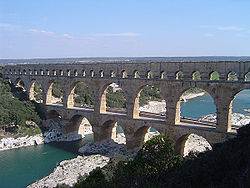
Nîmes became a Roman colony sometime before 28 BC, as witness the earliest coins which bear the abbreviation NEM. COL, "Colony of Nemausus".[2] Some years later a sanctuary and other constructions connected with the fountain were raised on the site. Nîmes was already under Roman influence, though it was Augustus who made the city the capital of Narbonne province, and gave it all its glory.
Augustus gave the town a ring of ramparts six kilometres long, reinforced by fourteen towers, with gates of which two remain today, the Porta Augusta and the Porte de France. The city had an estimated population of 60,000. He had the forum built. An aqueduct was built to bring water from the hills to the north. Where this crossed the River Gard between Uzes and Remoulins the spectacular Pont du Gard was built. This is 20 km north east of the city. Nothing remains of certain monuments, the existence of which is known from inscriptions or architectural fragments found in the course of excavations. It is known that the town had a civil basilica, a curia, a gymnasium and perhaps a circus. The amphitheatre dates from the end of the 2nd century AD. The family of Roman Emperor Antoninus Pius came from Nemausus.
The town was prosperous until the end of the third century. During the fourth and fifth centuries the nearby town of Arles enjoyed more prosperity. Emperor Constantine endowed the city with baths. It became the seat of the Diocesan Vicar, the chief administrative officer of southern Gaul. In the early fifth century the Praetorian Prefecture was moved from Trier in northeast Gaul to Arles. The city was finally captured from the Romans by the Visigoths in 473 AD.
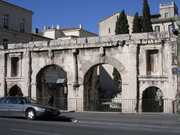

Fourth–thirteenth centuries
After the Gallo-Roman period, in the days of invasion and decadence, the Christian Church, already established in Gaul since the 1st century AD, appeared be the last refuge of classical civilization, remarkably organized and directed by a series of Gallo-Roman aristocrats. After the barbarian invasions the population had to face incursions by Moors from Spain (AD 710). The occupation came to an end in 754 under Pepin the Short. The town, ruined by so many troubles and invasions was now only a shadow of the opulent Gallo-Roman city. The local powers installed themselves in the amphitheatre.
Carolingian rule brought relative peace, but feudal times in the twelfth century brought local troubles which lasted until the days of St. Louis. During this period Nîmes was jointly administered by a lay power resident in the old amphitheatre, where lived the Viguier and the Knights of the Arena, and the religious power based in the Bishop's palace complex, around the cathedral, its chapter and the Bishop's house; meanwhile the city was represented by four Consuls who sat in the Maison Carrée.
Despite incessant feudal squabbling, Nîmes saw a certain progress both in commerce and industry as well as in stockbreeding and associated activities.
After the last effort by Raymond VII of Toulouse, St. Louis managed to establish royal power in the region which became Languedoc. Nîmes thus entered finally into the hands of the King of France.
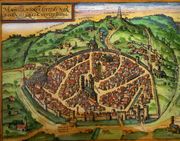
Period of invasions
During the fourteenth and fifteenth centuries the Rhone Valley underwent an uninterrupted series of invasions which ruined the economy and caused famine. Customs were forgotten, religious troubles developed (see French Wars of Religion) and epidemics, all of which affected the city. Nîmes, which was one of the Protestant strongholds, felt the full force of repression and fratricidal confrontations (including the Michelade massacre) which continued until the middle of the seventeenth century, adding to the misery of periodic outbreaks of plague.
Seventeenth century–French Revolution
In the middle of the seventeenth century Nîmes experienced a period of prosperity. Population growth caused the town to expand, and slum housing to be replaced. Also to this period dates the reconstruction of Notre-Dame-Saint-Castor, the Bishop's palace and numerous mansions (Hotels). This 'renaissance' strengthened the manufacturing and industrial vocation of the city, the population rising from 21,000 to 50,000 inhabitants.
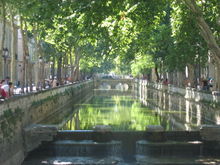
Also in this period the Fountain gardens, the Quais de la Fontaine, were laid out, the areas surrounding the Maison Carrée and the Amphitheatre were cleared of encroachments, whilst the entire population benefited from the atmosphere of prosperity.
Revolution to the present
Following a European economic crisis which hit Nîmes with full force, the Revolutionary period awoke slumbering demons of political and religious antagonism. The White Terror added to natural calamities and economic recession, produced murder, pillage and arson until 1815. Order was however restored in the course of the century, and Nîmes became the metropolis of Bas-Languedoc, diversifying its industry towards new kinds of activity. At the same time the surrounding countryside adapted to market needs and shared in the general increase of wealth.
Demographics
The population of Nîmes by year:[3][4]
| 1881 | 1891 | 1901 | 1911 | 1921 | 1931 | 1936 | 1954 | 1962 | 1968 | 1975 | 1982 | 1990 | 1999 | 2005 | 2008 |
|---|---|---|---|---|---|---|---|---|---|---|---|---|---|---|---|
| 63,552 | 71,623 | 80,605 | 80,437 | 82,774 | 89,213 | 93,736 | 89,107 | 99,775 | 123,292 | 127,933 | 124,220 | 128,471 | 133,406 | 144,600 | 149,000 |
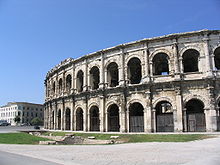
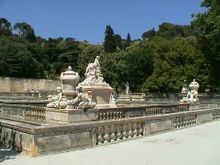
Main sights
Several important remains of the Roman Empire can still be seen in and around Nîmes:
- The elliptical Roman amphitheatre, of the first or second century AD, is the best-preserved Roman arena in France. It was filled with medieval housing, when its walls served as ramparts, but they were cleared under Napoleon. It is still used today as a bull fighting and concert arena.
- The Maison Carrée (Square House), a small Roman temple dedicated to sons of Agrippa was built c. 19 BC. It is one of the best-preserved Roman temples anywhere. Today, visitors can watch a short film about the history of Nimes inside.
- The 18th-century Jardins de la Fontaine (Gardens of the Fountain) built around the roman thermae ruins.
- The nearby Pont du Gard, also built by Agrippa, is a well-preserved aqueduct that used to carry water across the small Gardon river valley.
- The nearby Mont Cavalier is crowned by the Tour Magne ("Great Tower"), a ruined Roman tower.[5]
Later monuments include:
- The cathedral (dedicated to Saint Castor of Apt, a native of the city), occupying, it is believed, the site of the temple of Augustus, is partly Romanesque and partly Gothic in style.
- The Musée des Beaux-Arts de Nîmes
There is modern architecture at Nîmes too: Norman Foster conceived the Carré d'art (1986), a museum of modern art and mediatheque; Jean Nouvel the Nemausus, a post-modern residential ensemble, and Kisho Kurokawa a building in the form of a hemicycle to reflect the Amphitheatre.
Tree-shaded boulevards trace the foundations of its former city walls.
Economy
Nîmes is historically known for its textiles. Denim, the fabric of blue jeans, derives its name from this city (Serge de Nîmes).
Culture
The asteroid 51 Nemausa was named after Nîmes, where it was discovered in 1858.
Transportation
Nîmes-Alès-Camargue-Cévennes Airport serves the city.
Sport
Ligue 2 soccer team Nîmes Olympique is based in Nîmes.
Rugby team is RC Nîmes.
People born in Nîmes
- Domitius Afer (d. AD 60), Roman orator
- Antoninus Pius (86–161), Roman emperor
- Jean Nicot (1530–1600), diplomat, spread tobacco cultivation
- Antoine Court de Gebelin (1725–1784) Religious leader
- Jean-Paul Rabaut Saint-Etienne (1743–1793), French revolutionist
- François Guizot (1787–1874), historian, orator and statesman
- Benjamin Valz (1787–1867), astronomer
- Adolphe Crémieux (1796–1880), lawyer, statesman
- Alphonse Daudet (1840–1897), novelist
- Louis Rossel (1844–1871), Delegate of War (Paris Commune)
- Chantal Rega,athlete
Mayors
- Émile Jourdan, PCF (1965-1983)
- Jean Bousquet, UDF (1983–1995)
- Alain Clary, PCF (1995–2001)
- Jean-Paul Fournier, UMP (since 2001)
Twin towns
Nîmes twinned with:
 Preston, United Kingdom, since 1955.
Preston, United Kingdom, since 1955.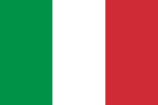 Verona, Italy, since 1960.
Verona, Italy, since 1960.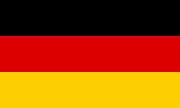 Braunschweig, Germany, since 1962.
Braunschweig, Germany, since 1962. Prague, Czech Republic, since 1967.
Prague, Czech Republic, since 1967. Frankfurt, Germany, since 1976.
Frankfurt, Germany, since 1976.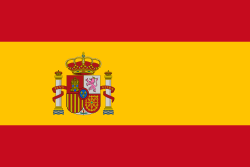 Salamanca, Spain, since 1979.
Salamanca, Spain, since 1979. Rishon LeZion, Israel, since 1986.
Rishon LeZion, Israel, since 1986. Meknes, Morocco, since 2005.
Meknes, Morocco, since 2005.
See also
- Costières de Nîmes AOC
- Nîmes-Alès-Camargue-Cévennes Airport
References
- ↑ Alain Veyrac, "Le symbolisme de l'as de Nîmes au crocodile" Archéologie et histoire romaine vol. 1 (1998) (on-line text).
- ↑ Colin M. Kraay, "The Chronology of the coinage of Colonia Nemausus", Numismatic Chronicle 15 (1955), pp75-87.
- ↑ Insee Census
- ↑ Insee Census
- ↑ Giving rise to the example of rime richissime Gall, amant de la Reine, alla (tour magnanime)/ Gallament de l'Arène a la Tour Magne, à Nîmes, or "Gall, lover opf the Queen, passed (magnanimous gesture), gallantly from the Arena to the Tour Magne at Nîmes".
External links
- Practical Guide to Nîmes Airport
- City council website
- The official Web site of Roman Nîmes
- Images of Roman remains of Nîmes
- Photogallery of Nîmes
- Photos & Map of Nîmes
- Regordane Info - The independent portal for The Regordane Way or St Gilles Trail The Regordane passes through Nîmes. (in English and French)
|
|||||